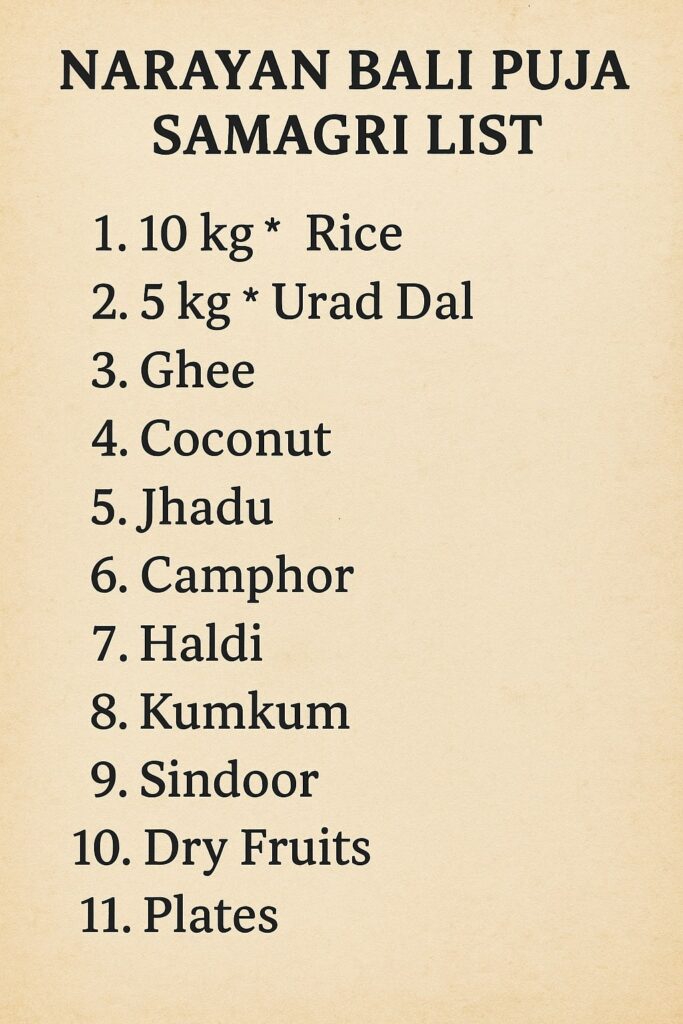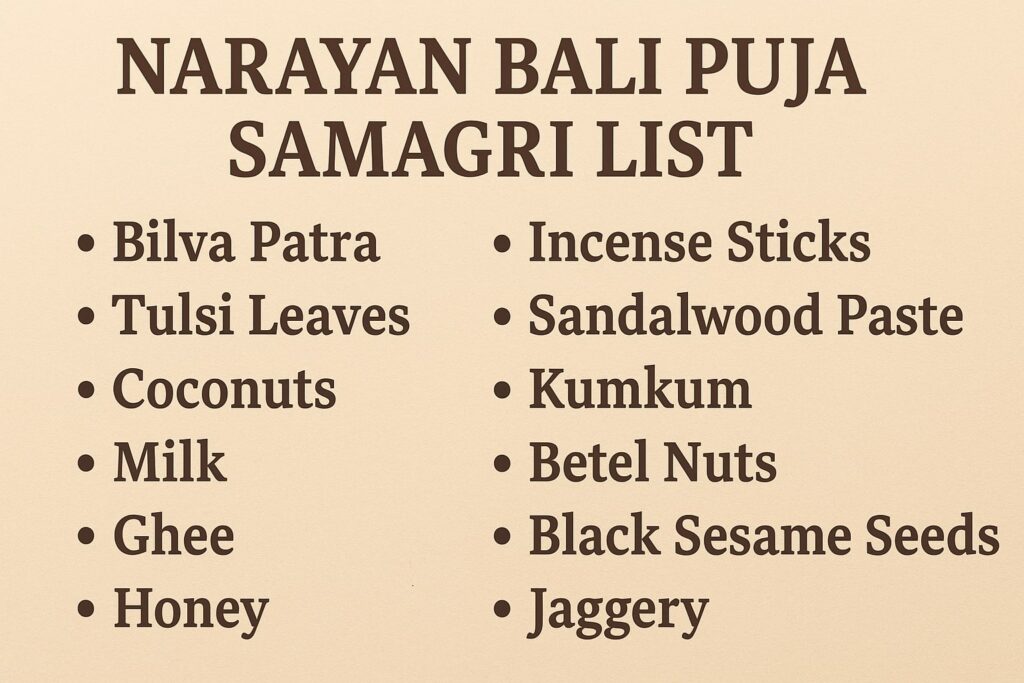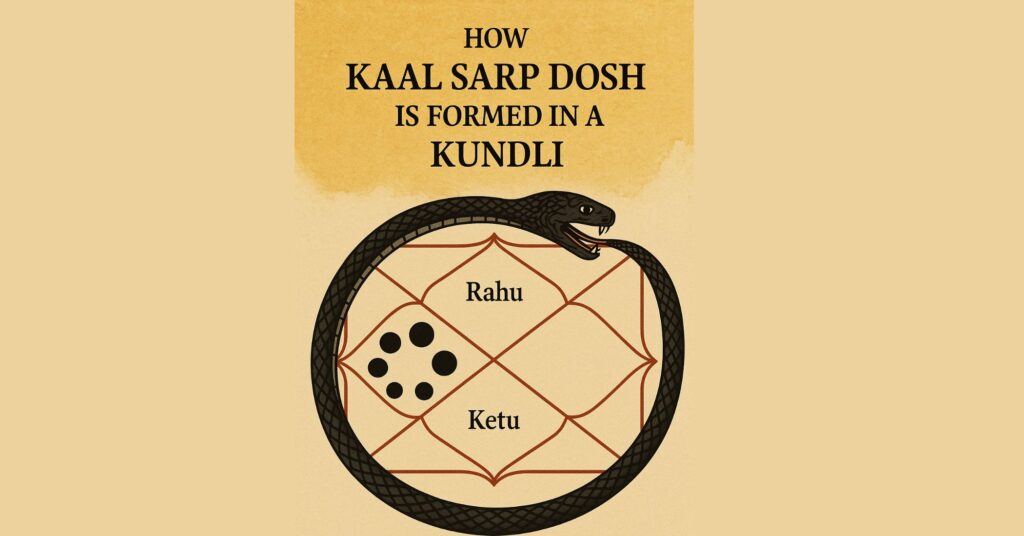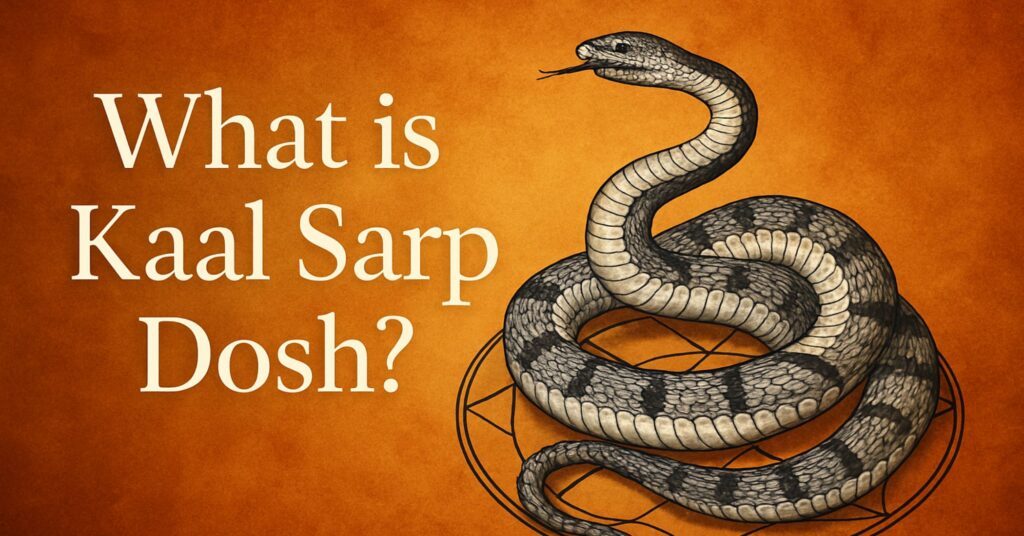In the realm of Vedic rituals, certain poojas hold immense significance for both spiritual and material well-being. Among these, the Narayan Bali Puja is considered one of the most powerful. It is a sacred ritual performed to provide peace to departed souls and to remove the negative effects of ancestral curses, known as Pitru Dosh. This puja is particularly necessary for families who are encountering successive setbacks, untimely death, or failure in life because of unresolved ancestral karma. In this blog, we will take a closer look at the Narayan Bali Puja Samagri list, examining the significance of each item and how the puja impacts the lives of devotees.
Although the puja itself is extremely spiritual and is performed by very highly trained priests, perhaps one of the most important things about the puja is the samagri—the spiritual items and offerings that are made during the ceremony.

What is Narayan Bali Puja?
The Narayan Bali Puja is a Vedic ceremony done to free the souls of ancestors who have passed away unnaturally or whose wishes have not been fulfilled. It is particularly recommended for people who are suffering from Pitru Dosh or are experiencing problems like:
Delays in marriage or childbirth
Repetitive losses of money
Dissensions and disharmony at home
Health issues without any medical reason
Premature or unnatural deaths within the family
The tradition entails making effigies of ancestors using wheat flour, representing the souls symbolically, and offering prayer and pind daan (offering food) to ensure peace and freedom for them. Through this process, the family is blessed by their ancestors, thereby eradicating long-standing issues.
Significance of Puja Samagri
All Vedic rituals entail particular items that have symbolic and spiritual significance. Samagri involved in Narayan Bali Puja is not merely about offerings—it achieves a linking of the physical and spiritual realms. Each object plays a part in calling forth divine energies, appeasing the ancestors, and facilitating the successful completion of the puja.
If one samagri is missing or misused, the ritual becomes ineffective. This is the reason that the presence of an experienced guru is essential to lead the devotees and ensure that each step is taken as per ancient scriptures.
Narayan Bali Puja Samagri List
The following is a comprehensive list of substances used for the Narayan Bali Puja:
1. Wheat Flour (Gahu ka Atta)
Wheat flour is utilised to make the effigies (bodies) of the deceased souls. The effigies serve as symbolic embodiments of the ancestors on whose behalf the ritual is done.
2. Black Sesame Seeds (Kale Til)
Sesame seeds are revered in Hindu rituals. They are employed during tarpan (water offering) and pind daan since they are assumed to satiate ancestral souls.
3. Rice (Akshata)
Unbroken rice grains sprinkled with turmeric are offered for praying. Rice is a symbol of prosperity, purity, and nourishment.
4. Kusha Grass (Darbha)
Kusha is held in very high esteem in Vedic rituals. Kusha is a medium for inviting divine energies and is usually kept during tarpan and havan.
5. Flowers (Pushpa)
Fresh marigolds and lotus flowers are offered to the deities and ancestors. Flowers represent devotion, purity, and divine blessings.
6. Tulsi Leaves
Tulsi or holy basil is considered the most revered of all Hindu plants. It cleanses the atmosphere and is utilised for tarpan and havan rituals.
7. Pind (Rice Balls)
Made from rice, black sesame, and ghee, pindas are administered as food for the souls of the ancestors. It is the most important part of the ritual.
8. Ghee (Clarified Butter)
Ghee is offered in havan (fire offerings). Ghee is thought to take the mantras to the gods when it is offered to the fire.
9. Fruits
Fruits like bananas, coconuts, and seasonal fruits are offered as naivedya (food offerings). They symbolise purity and sustenance for the ancestors.
10. Coconut
Coconut symbolises sacrifice and purity. Coconut is broken during the puja as an offering to the gods and ancestors.
11. Betel Leaves and Betel Nuts
They are utilised as symbolic gifts in Hindu rituals. They symbolise respect and gratitude to ancestors.
12. Incense Sticks and Camphor
Incense cleanses the surroundings and forms a spiritual ambience. Camphor, when ignited, signifies the ignition of ego and negativity.
13. Holy Water (Gangajal)
Sacred Ganga water is employed in nearly all Vedic rituals. It cleanses the samagri and charges the ritual space.
14. Ancestors’ Clothes (Vastra)
In certain cultures, brand-new clothes are symbolically given to ancestors at the time of Narayan Bali Puja. This is an expression of devotion and respect.
15. Kalash (Sacred Pot)
A brass or copper pot containing water and adorned with mango leaves and coconut is employed as a symbol of divine presence.
16. Panchamrit (Five Sacred Substances)
A blend of milk, curd, honey, ghee, and sugar, Panchamrit is given as a sign of purity and divine sustenance.
17. Havan Samagri
A blend of sacred herbs, wood, and grains utilised in the havan. The Havana smoke is claimed to cleanse the atmosphere and attract blessings.
18. Oil Lamp (Diya)
A diya is a sign of light and divine presence. It is lit during the puja to drive away negativity and usher in prosperity.
Step-by-Step Application of Samagri
Purification
Holy water (Gangajal) and kusha grass are applied to purify the environment.
Sankalp (Vow)
Flowers and rice are utilised while taking sankalp, where devotees make a vow to conduct the puja in all earnestness.
Effigy Preparation
Wheat flour is applied to prepare symbolic effigies of ancestors.
Offerings (Pind Daan & Tarpan)
Pindas made of rice, black sesame seeds, and ghee are offered with flowers, kusha, and tulsi leaves.
Havan
Ghee, camphor, havan samagri, and incense are used for fire offerings.
Final Offerings
Fruits, betel leaves, and clothes are offered to symbolise devotion and respect.
Benefits of Narayan Bali Puja
Liberation of ancestral souls and removal of Pitru Dosh
Relief from obstacles in career, marriage, and childbirth
Peace and harmony in domestic life
Resolution of money matters and illness
Protection against unnatural or premature deaths
Spiritual upliftment and divine favour
Why an Experienced Guru is Important
Although samagri is paramount, the real key to Narayan Bali Puja is proper chanting of mantras and adherence to ritual protocols. Nothing but a learned and experienced guru can guarantee that the puja will be done correctly and give maximum returns.
Conclusion
The Narayan Bali Puja Samagri is not merely a collection of things but a group of divine instruments that serve to form a medium between the world of the living and the spiritual realm of ancestors. Every object is rich in meaning and served in a particular manner to make the puja serve its holy mission of freedom, peace, and blessings.
Performing Narayan Bali Puja with proper samagri and under the guidance of a learned guru yields great advantages, such as the eradication of Pitru Dosh, peace at home, prosperity, and spiritual development.Among the revered gurus at Trimbakeshwar, Shivendra Guru Ji stands out as the finest pandit to perform Kaal Sarp Puja and Narayan Nagbali Puja. One of the most seasoned and reliable pandits for Kaal Sarp Dosh Puja in Trimbakeshwar, he is renowned for conducting the rituals with full Vedic practices and dedication. Book your Narayana Bali Pooja with an experienced and knowledgeable Pandit for authentic rituals and peace of mind. Contact us!
Author: Shivendra Guru Ji
For an accurate and authentic puja, Shivendra Guru Ji is the best pandit for Kaal Sarp Puja in Trimbakeshwar. With years of experience and unmatched spiritual discipline, he ensures each ritual is conducted with precision, sanctity, and divine energy.
Feel free to connect with me on Instagram, and book your Kalsarp Dosh Shanti Pooja at Trimbakeshwar Temple in Nashik with an experienced and knowledgeable Pandit for authentic rituals and peace of mind.
Bonus Tips – Best pandit for kaal sarp dosh puja
FAQs on Narayan Bali Puja Samagri List
Why is Narayan Bali Puja done?
Narayan Bali Puja is done to provide peace and liberation to the souls of the deceased, eliminate Pitru Dosh (ancestral curse), and solve issues such as delay in marriage, losses, diseases, and familial conflicts.
2. Why does samagri play a special role in Narayan Bali Puja?
Samagri (ritual materials) are required because they hold spiritual values. Every material, like wheat flour, black sesame seeds, kusha grass, and ghee, has a special purpose of its own in seeking divine blessings and attuning to ancestral souls.
3. Is Narayan Bali Puja possible without the use of all samagri?
No, each item in the samagri list serves a special purpose. The puja will not be effective if any significant samagri is omitted. That’s why it is always best to have the puja done under the direct instruction of an experienced guru who makes sure that everything is in place.
4. How long does the Narayan Bali Puja take?
The puja would take 1 to 1.5 days, depending on traditions and the priest performing the rituals. Sometimes it is done together with Nagbali Puja, which would lengthen it.



